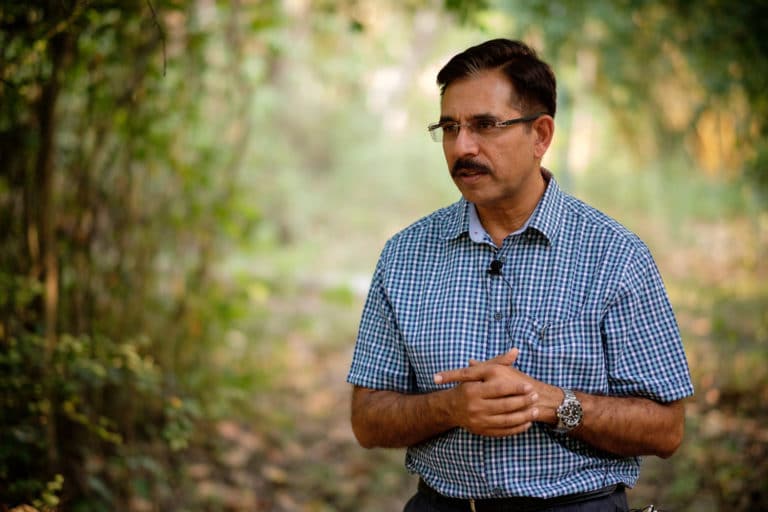Since it was Jhala who laid the technological foundation for the ambitious cheetahs initiative under several governments starting in 2009, his removal has sparked concerns.

Jhala has been working since 2009 to import cheetahs to India under several governments. He was also the primary author of the 2022 Cheetah Action Plan and oversaw the technical negotiations with Namibian and South African biologists.
The National Tiger Conservation Authority (NTCA) established a new nine-person task force on September 20 to keep an eye on the eight Cheetahs that had been flown in from Namibia earlier that month. A report in the Indian Express claims that this task committee is missing one important member, renowned biologist Yadavendradev Vikramsinh Jhala.
Yadavendradev Vikramsinh Jhala, dean of the Wildlife Institute of India and a renowned scientist who has led India’s cheetah initiative for more than 13 years and escorted the first shipment of cats from Namibia last month, has not been given a position on the government’s new Cheetah Task Force.
Since it was Jhala who laid the technological foundation for the ambitious cheetah initiative under several governments starting in 2009, his removal has sparked concerns. He was a member of the Cheetah Task Force, which was founded in 2010 by environmentalist MK Ranjitsinh, and has since been in charge of the project’s technical staff.

The first group of cheetahs eventually departed Namibia on September 16:
When The Indian Express questioned Ranjitsinh about Jhala’s exclusion and its potential effects, he stated that he had not been involved in the process of creating the new task group or choosing its members.
When the first group of cheetahs eventually departed Namibia on September 16, it was Jhala who traveled with them to Kuno national park where they were housed in bomas (tiny enclosures) under his supervision. Before departing, he spent a week keeping an eye on the cheetahs in Kuno.
After being tasked with the study in 2009 by the then-Environment Minister Jairam Ramesh, Jhala compiled the initial report with Ranjitsinh. He was the primary author when India completed the Cheetah Action Plan in January 2022. Jhala had also been in charge of the technical consultations with South African and Namibian wildlife biologists.
Jhala, however, was unable to join the nine-person task force that the National Tiger Conservation Authority (NTCA) assembled on September 20 to observe how the eight cheetahs from Namibia adapt to their new environment and determine when to release them into larger enclosures and eventually into the open.
The NTCA reintroduced the Cheetah project in 2017 after the Supreme Court rejected it in 2013. Since “it is not desirable that (the project)… be left to the sole discretion of the NTCA,” the SC permitted it in 2020 under a three-member committee led by Ranjitsinh.
Regarding Jhala’s absence from the task team, which also includes representatives from the MP government, NTCA member-secretary SP Yadav declined to comment. According to a representative close to Yadav, Jhala’s participation might provide a conflict of interest. “The new task force’s mandate is to keep an eye on the project. He (Jhala) is unable to oversee his own work, he claimed.

That’s a weak justification, a professional who wished to remain unnamed stated. “The task force’s mandate is highly technical, but there isn’t a single technical member on it. It is not the task force’s responsibility to monitor the cheetahs.
Jhala may have “rubbed the establishment the wrong way,” according to sources. For instance, according to sources, he refused to allow cheetahs to travel from Gwalior to Kuno in a Chinook, a twin-rotor helicopter utilized for the event’s trial run and designated for the flight, due to the extraordinarily high noise stress the cats would have experienced.
The cats were given tranquilizers because it is dangerous to entirely knock them out for an extended period of time (to shield them from noise). The cheetahs were flown in two Mi-17 aircraft with Jhala on board after Jhala put his foot down. A Chinook was also utilized, but only to transport a small group of project participants to Kuno, according to the official.
On September 17, Prime Minister Narendra Modi visited Kuno to release the cheetahs, but Jhala was not one of the 20 dignitaries — ministers and bureaucrats — who were allowed access to and were photographed with him.
When questioned about it, the top NTCA representative responded, “These things happen. Jhala was not the only top official who was unable to obtain a proximity pass.












